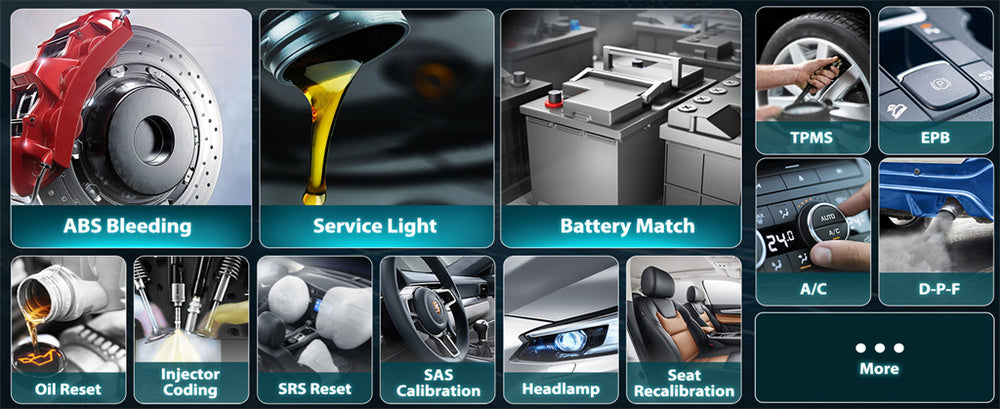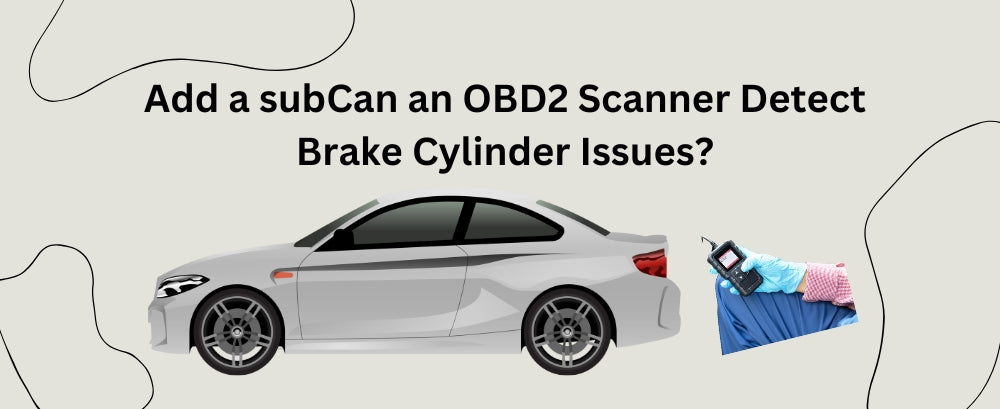Project cars like a small block Chevy equipped with a carburettor can be great fun for automotive enthusiasts. It's like diving into a new world where gasoline smells fill your nostrils and engines hum peacefully and harmoniously.
Diagnosing engine or electrical issues with proper tools is like solving a Rubik's cube blindly; here is where your OBD-II scanner becomes your personal car whisperer!
We will explore the ins and outs of OBD-II scanners such as Foxwell's NT809BT OBD II scanner and other essential diagnostic scan tools that should be part of every DIYer's toolbox.
Why an OBD-II Scanner Is Essential for Diagnosing Engine and Electrical Issues

Let's be clear: an OBD-II scanner is much more than just a tool—it's like having a translator for your car's inner thoughts. Every modern vehicle is an individual entity with its mind; however, unable to speak out loud directly, it knows exactly how to send you cryptic signals via lights such as the "Check Engine" light that indicates an issue, whether minor or severe.
The Foxwell NT809BT is an example of how technology has revolutionized DIY car repairs. Plugged into your OBD-II port (usually under the dashboard), this tool retrieves Diagnostic Trouble Codes (DTCs).
These DTCs help pinpoint exactly what's ailing your engine or electrical systems—be it engine misfiring, miswiring, or an electrical short. In addition to simply displaying them as numbers on screen, this device provides plain-language descriptions, so there's no need to Google obscure numbers to figure out what might be wrong!
But this scanner stands out: its wireless design lets you move freely around the vehicle while scanning and troubleshooting. Bluetooth connection makes for seamless diagnostics sessions; no longer are diagnostics conducted hunched over your steering wheel!
Although classic project cars built before 1996 may not have OBD-II ports, an OBD-II scanner becomes invaluable when adding modern updates such as fuel injection or switching ignition systems.
How to Use an OBD-II Scanner for Diagnosing Common Car Issues
The Foxwell NT809BT takes the guesswork out of car diagnostics. With access to it, users can have a roadmap for solving car issues instead of aimlessly replacing parts. Here's how this device can be used to pinpoint common car issues:
Attaching the Foxwell NT809BT to Your Car
Locate the OBD-II port under your driver's dashboard. The Foxwell NT809BT's Bluetooth dongle and scanner tablet connect wirelessly automatically, providing wireless connectivity. This allows you to work outside or check underneath while monitoring live data in real time.
Retrieve Diagnostic Trouble Codes (DTCs)
Once connected, the NT809BT will search for Diagnostic Trouble Codes (DTCs). DTCs serve as error messages that tell you exactly what's wrong.
Unlike standard OBD-II tools, however, the NT809BT decodes these numbers and provides you with their meaning. For instance, if your Check Engine Light illuminates, this tool provides clear explanations, such as oxygen sensor failure or misfires.
Diagnosing Engine Problems with DTCs
Say your scanner detects a P0301 code indicating a misfire in cylinder 1; instead of making random parts swaps, you could focus your efforts on the ignition system for that specific cylinder.
Use live engine data such as fuel trim or oxygen sensor readings with your NT809BT to get even greater detail - perfect for tracking down throttle response lag or vacuum leaks quickly without spending unnecessary time and money on troubleshooting efforts.
Solving Electrical Issues With the Foxwell NT809BT
Electrical problems often feel like an endless maze, but Foxwell's NT809BT can help simplify things. It is designed to detect faults in your car's ABS, airbags, and charging system and can detect failing sensors.
It also provides live data to verify whether replaced parts function as promised after replacement. Being capable of checking various systems, from engine control units to airbags, makes this device the ultimate tool for combatting electrical gremlins!
Utilizing Special Functions
The Foxwell NT809BT goes beyond simply scanning bar codes; it also offers unique functions to make this device even more valuable. These functions include:
Resetting the oil service light following an oil change, calibrating throttle position sensors after adjustments, registering batteries on vehicles equipped with advanced charging systems, and finally, resetting steering angle sensors after performing suspension or alignment work are crucial steps.
The NT809BT is far beyond just another basic scanner; its array of functionality makes it a professional-grade tool that helps you avoid expensive trips to your mechanic for basic resets.
Clearing Fault Codes and Verifying Repairs
Once you've identified and fixed a problem, use the NT809BT scanner to clear any fault codes left by repairs made to your car.
If successful repairs were implemented, your Check Engine Light should go off, while no new codes may have appeared during scanning; this final step ensures that any issues have been fully addressed so you can safely drive again with confidence.
Troubleshooting Engine Issues with OBD-II Codes
An OBD-II scanner like the Foxwell NT809BT makes engine troubleshooting much more straightforward. Let's say your car displays a P0171 code, indicating engine leanness.
This could indicate anything from a vacuum leak to an issue with the mass airflow sensor or fuel injector, such as fuel injector failure.
Using the NT809BT's live data analysis capabilities, you can track air/fuel ratio changes and pinpoint whether they are related to airflow issues or fuel delivery.
Diagnostic precision ensures you will avoid wasting time replacing parts that aren't malfunctioning, regain control, and help solve issues swiftly and accurately.
Identifying Electrical Problems Using an OBD-II Scanner
While engine problems tend to receive the spotlight, electrical problems are just as prevalent—and just as frustrating.
ith the Foxwell NT809BT OBD-II scanner, you can quickly identify electrical issues in multiple systems, including ABS brakes, airbags (SRS), battery charging systems, and much more!
If your ABS warning light comes on, the NT809BT can identify which component has failed: a malfunctioning sensor or communication failure between the ABS module and ECU.
Furthermore, after making recent brake repairs or adjustments, this scanner can help reset the system and ensure everything runs smoothly. Likewise, with airbag systems, if their warning lights come on, the NT809BT can identify defective sensors, helping avoid unnecessary repairs.
Essential Tools to Pair with Your OBD-II Scanner
Even the Foxwell NT809BT can't cover everything. Here are a few other tools that should help address various engine and electrical issues:
- Multimeter: Ideal for measuring voltage, resistance and current in electrical circuits.
- Compression Tester: Helps diagnose engine health by checking compression levels. Spark Plug Tester: Crucial in ensuring your spark plugs are functioning effectively.
- Timing Light: Ideal for tuning older engines to ensure proper ignition timing. Vacuum Gauge: Useful in diagnosing vacuum leaks that cause rough idling or other engine-related issues.
These tools, combined with the NT809BT, give you everything you need to address common car issues, both modern and classic.
Choosing the Right OBD-II Scanner for Your Project Car
Not all OBD-II scanners are created equal, and Foxwell NT809BT strikes an excellent balance between price and professional-grade functionality.
Perfect for DIYers starting out or experienced mechanics alike, its wireless capabilities, real-time data monitoring capabilities, and special functions make this an outstanding choice for OBD II scanner users of all levels of experience.
Before purchasing an OBD-II scanner, be mindful of the following:
Vehicle Compatibility: Ensure your selected device accommodates your project car and daily driver. Feature Selection: Look for features like live data feeds and system-specific diagnostics. At the same time, Ease of Use considerations make a substantial difference when troubleshooting.

The Role of Non-OBD-II Tools in Engine and Electrical Repairs
While an OBD-II scanner like the Foxwell NT809BT is essential when working on older, carbureted engines, non-OBD tools like timing lights and vacuum gauges will also prove indispensable for adequately servicing them.
They enable you to fine-tune settings or troubleshoot issues that OBD-II cannot address; their combination ensures you'll always be ready for anything that comes your way.
Conclusion
Finally, using diagnostic tools is critical to providing efficient car repair. When combined with traditional tools like multimeters or compression testers, these tools will give you everything necessary for modern and classic vehicle ownership. The Foxwell NT809BT should be one of those essential tools you have available when diagnosing engine or electrical problems efficiently—it makes diagnosis fun!
Prepare yourself, get your hands dirty, and relish the process of bringing back to life your project car!
FAQs
What diagnostic tool do mechanics use?
Mechanics often use professional-grade OBD-II scanners, like the Foxwell NT809BT or similar advanced tools. These scanners allow them to diagnose a broad range of issues, from engine problems to ABS, airbag, and transmission faults. These tools provide deeper insights than basic scanners and can access more vehicle modules.
What should I look for when buying a car diagnostic tool?
When buying a car diagnostic tool, you should consider:
- Compatibility: Ensure the scanner works with your car’s make and model.
- Features: Look for advanced options such as live data monitoring, wireless connectivity, and functions like service light resets or sensor calibrations.
- Ease of Use: A user-friendly interface with clear code explanations is important, especially if you're not a professional.
Can I do a car diagnostic myself?
Absolutely! With tools like the Foxwell NT809BT, you can easily perform car diagnostics at home. It’s as simple as plugging in the scanner, reading the codes, and following the guidance to fix the problem. No need to be a mechanic—you can clear fault codes and reset warnings yourself with ease.




Leave a comment
This site is protected by hCaptcha and the hCaptcha Privacy Policy and Terms of Service apply.